Why you can trust Tom's Hardware
One of the bigger selling points for the Arc A380, and Intel's Arc Alchemist GPUs in general, is the support for hardware accelerated AV1 and VP9 video encoding. Current AMD and Nvidia GPUs only support hybrid decoding of VP9 and AV1, where some of the work is done by the CPU, and both codecs can prove quite taxing of lesser CPUs.
We took four video clips and then used FFmpeg to encode them at various bitrates. One of the videos is a 1080p source, while the other three are 4K videos. For 1080p, we used bitrates of 3 Mbps, 6 Mbps, and 8 Mbps; on the 4K videos, we used 8 Mbps, 12 Mbps, and 16 Mbps. Generally speaking, 4K encoding (with four times as many pixels) ends up taking three to four times longer than 1080p encoding, or if you prefer, it requires three to four times as much computational power.
We used Intel's Cartwheel-FFmpeg for the AV1 encoding, and actually couldn't figure out the correct way to do VP9 encoding, while the latest public nightly release was used for the AMD and Nvidia GPUs. We also used FFmpeg to perform VMAF (Video Multi-Method Assessment Fusion) quality comparison of the encoded files. VMAF was created by Netflix as a way to assess the quality of various codecs and bitrates, with scores of 90 or above being "generally indistinguishable" from the source content, scores of 80–90 are good, 70–80 is adequate, and below that the blocking and artifacts become clearly visible.
We've provided the charts for the encoding speed (FPS) and encoding quality (VMAF), along with tables of the raw data for those that want the exact numbers. Other encoding software solutions may have different results. We did try using HandBrake (Nightly) for some tests as well, but ultimately ran into some difficulties and found that FFmpeg was easier to use.

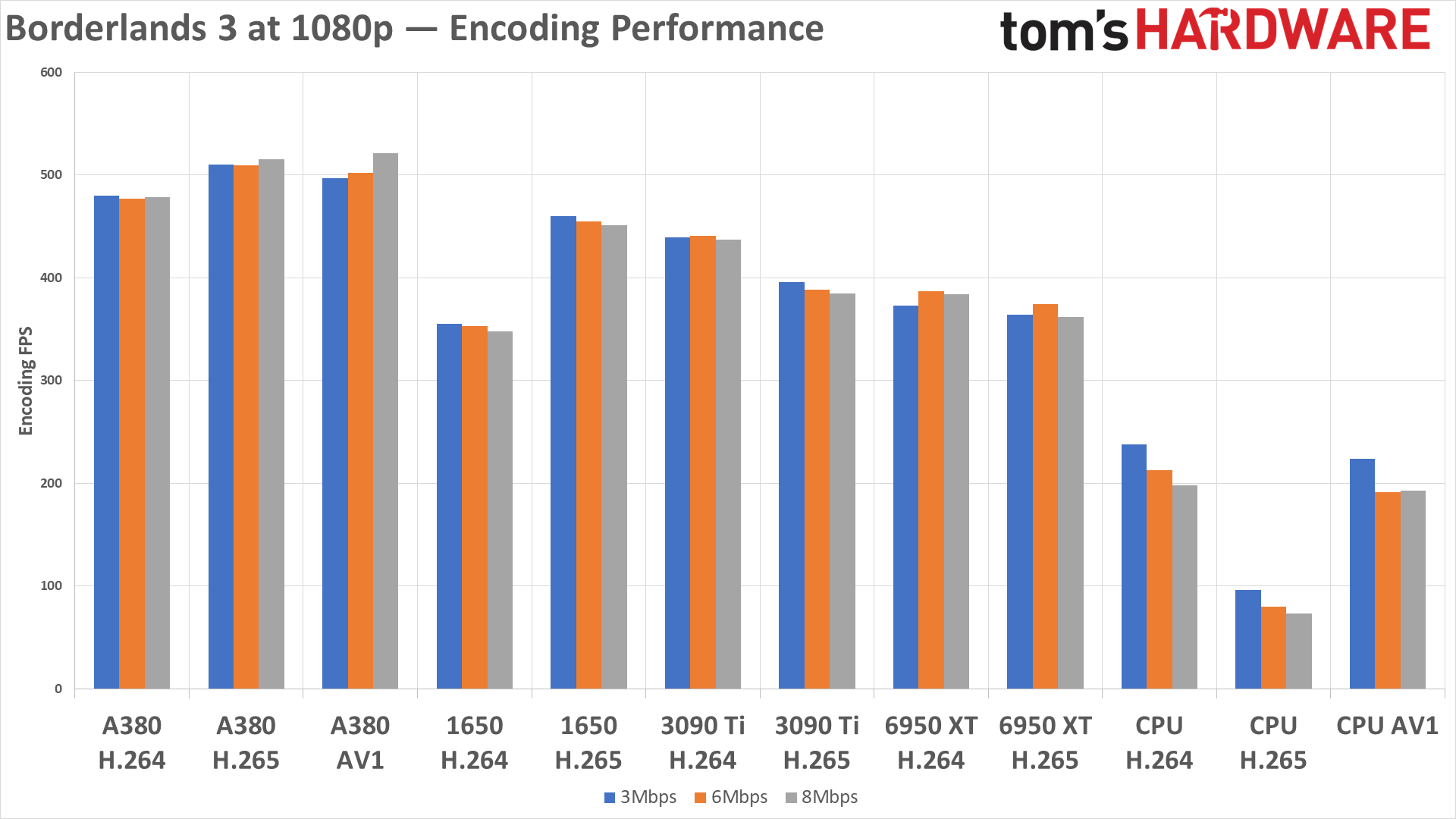






| Encoder | FPS 3M | VMAF 3M | FPS 6M | VMAF 6M | FPS 8M | VMAF 8M |
|---|---|---|---|---|---|---|
| A380 H.264 | 480 | 76.4 | 477 | 81.11 | 478 | 91.31 |
| A380 H.265 | 510 | 84.74 | 509 | 88.71 | 515 | 95.12 |
| A380 AV1 | 497 | 82.5 | 502 | 85.6 | 521 | 93.4 |
| CPU H.264 | 238 | 74.19 | 213 | 81.69 | 198 | 92.05 |
| CPU H.265 | 95.9 | 81.51 | 80.25 | 85.09 | 73.5 | 93.08 |
| CPU AV1 | 224 | 84.76 | 191 | 86.93 | 193 | 93.42 |
| 1650 H.264 | 355 | 76.86 | 353 | 89.04 | 348 | 92.41 |
| 1650 H.265 | 460 | 83.02 | 455 | 91.02 | 451 | 93.49 |
| 3090 Ti H.264 | 439 | 77.38 | 441 | 82.94 | 437 | 92.62 |
| 3090 Ti H.265 | 396 | 83.75 | 388 | 87.08 | 385 | 94.07 |
| 6950 XT H.264 | 373 | 65.79 | 387 | 71.12 | 384 | 86.79 |
| 6950 XT H.265 | 364 | 79.02 | 374 | 81.39 | 362 | 91.72 |
| Encoder | FPS 8M | VMAF 8M | FPS 12M | VMAF 12M | FPS 16M | VMAF 16M |
|---|---|---|---|---|---|---|
| A380 H.264 | 119 | 74.94 | 121 | 82.02 | 108 | 87.14 |
| A380 H.265 | 142 | 84.58 | 142 | 89.49 | 122 | 92.36 |
| A380 AV1 | 133 | 83.28 | 135 | 88.5 | 135 | 91.56 |
| CPU H.264 | 66 | 66.33 | 63 | 77.65 | 60 | 84.31 |
| CPU H.265 | 28 | 81.59 | 27.5 | 87.28 | 26.3 | 90.58 |
| CPU AV1 | 82 | 83.48 | 80 | 87.66 | 74 | 90.23 |
| 1650 H.264 | 95 | 71.53 | 94 | 80.67 | 92 | 86.38 |
| 1650 H.265 | 120 | 83.81 | 119 | 89.05 | 118 | 92.08 |
| 3090 Ti H.264 | 116 | 72.42 | 116 | 81.55 | 116 | 86.85 |
| 3090 Ti H.265 | 108 | 83.62 | 106 | 88.99 | 105 | 91.86 |
| 6950 XT H.264 | 121 | 60.66 | 120 | 72.78 | 121 | 80.4 |
| 6950 XT H.265 | 121 | 78.69 | 120 | 85.57 | 121 | 89.59 |
| Encoder | FPS 8M | VMAF 8M | FPS 12M | VMAF 12M | FPS 16M | VMAF 16M |
|---|---|---|---|---|---|---|
| A380 H.264 | 120 | 76.3 | 121 | 82.44 | 121 | 86.62 |
| A380 H.265 | 142 | 84.03 | 143 | 88.15 | 143 | 90.8 |
| A380 AV1 | 138 | 84 | 137 | 88.53 | 138 | 91.16 |
| CPU H.264 | 63 | 69.45 | 59 | 80.19 | 57 | 86.07 |
| CPU H.265 | 27.1 | 83.9 | 25.5 | 88.6 | 24.2 | 91.29 |
| CPU AV1 | 88 | 83.99 | 84 | 87.89 | 81 | 90.24 |
| 1650 H.264 | 95 | 73.81 | 94 | 81.85 | 94 | 86.4 |
| 1650 H.265 | 121 | 85.43 | 120 | 89.83 | 120 | 92.32 |
| 3090 Ti H.264 | 116 | 74.59 | 116 | 82.53 | 115 | 86.97 |
| 3090 Ti H.265 | 109 | 84.11 | 109 | 88.52 | 107 | 90.56 |
| 6950 XT H.264 | 119 | 65.51 | 121 | 75.88 | 121 | 82.12 |
| 6950 XT H.265 | 122 | 80.36 | 121 | 86.5 | 121 | 89.87 |
| Encoder | FPS 8M | VMAF 8M | FPS 12M | VMAF 12M | FPS 16M | VMAF 16M |
|---|---|---|---|---|---|---|
| A380 H.264 | 119 | 70.28 | 119 | 76.2 | 118 | 81.09 |
| A380 H.265 | 138 | 79.33 | 138 | 84.24 | 139 | 87.59 |
| A380 AV1 | 128 | 79.68 | 129 | 84.64 | 130 | 87.73 |
| CPU H.264 | 63 | 64.62 | 59 | 73.75 | 57 | 79.94 |
| CPU H.265 | 23.9 | 78.2 | 23.2 | 84 | 22 | 86.78 |
| CPU AV1 | 83 | 78.39 | 73 | 83.06 | 69 | 86.07 |
| 1650 H.264 | 97 | 66.35 | 96 | 73.08 | 95 | 78.27 |
| 1650 H.265 | 121 | 80.27 | 120 | 85.17 | 119 | 88.26 |
| 3090 Ti H.264 | 117 | 66.99 | 117 | 74.44 | 116 | 79.67 |
| 3090 Ti H.265 | 113 | 78.42 | 111 | 83.47 | 110 | 86.53 |
| 6950 XT H.264 | 121 | 66.9 | 122 | 69.6 | 122 | 74.92 |
| 6950 XT H.265 | 121 | 74.38 | 121 | 80.22 | 122 | 84.33 |
One thing that's immediately obvious is just how bad AMD's H.264 encoding is compared to the competition. Performance is fine, but it's consistently last place in quality, with the only result that was in second to last being Saints Row 4K at 8 Mbps, where it tied Nvidia's H.264 result and beat the libx264 CPU result.
What you might not have expected is that Intel's AV1 GPU encoding really only matches the quality offered by Intel and Nvidia with HEVC / H.265. The problem as mentioned earlier with HEVC is that it's not royalty free, and while that's theoretically also true of H.264, royalties generally weren't as steep or perhaps even collected at all. AV1 and VP9 are royalty-free alternatives to HEVC, and as such they're more likely to win out over the long term.
YouTube has begun experimenting with AV1, as a slightly higher-quality alternative to VP9. Twitch and other services may also begin supporting AV1 streaming, which means for example that you could stream 1080p at 3 Mpbs and get better quality than H.264 at 6 Mpbs. You could also do 4K 8Mbps AV1 livestreams and still get higher or equivalent quality to H.264 16 Mbps streams.
As far as encoding performance goes, all of the GPUs are quite a bit faster than even the fastest (current) CPU, with the A380 generally doubling the performance of the 12900K. More importantly, the encoding happens in a dedicated QSV (QuickSync Video) unit on the Intel GPU, so it shouldn't impact gaming performance in any meaningful way.
We can mostly say the same for the AMD and Nvidia encoders, though Nvidia's NVENC has slightly higher performance than AMD's VCE at 1080p and lower performance at 4K. Both are well past the 60 fps mark, however, which is really all that's needed for real-time video streaming.
An interesting side note is the GTX 1650 (TU117) encoding performance and quality. H.264 clearly got faster with Turing and Ampere, but the quality didn't change much. H.265 encoding meanwhile was actually faster on the 1650, with generally slightly higher quality as well. (Incidentally, we also tested a GTX 1650 Super with TU116 and saw virtually identical results to the RTX 3090 Ti.) Our encoding fps metric doesn't include gaming in the background, however, and we understand Turing also reduced the hit to gaming fps if you're livestreaming.
As for CPU encoding, 1080p using the latest Intel AV1SVT codec and FFmpeg isn't actually too shabby. 1080p could easily be done on the "efficiency" E-cores for a CPU like the 12900K at 60 fps or more. 4K on the other hand would use almost the entire CPU to get throughput of anywhere from 69 to 88 fps, depending on the bitrate and video content, so 4K live streaming with just the CPU would be difficult to achieve in many games. The upcoming Raptor Lake CPUs with double the number of E-cores on the other hand should prove sufficient, assuming the software is smart enough to leave the P-core for the game content.





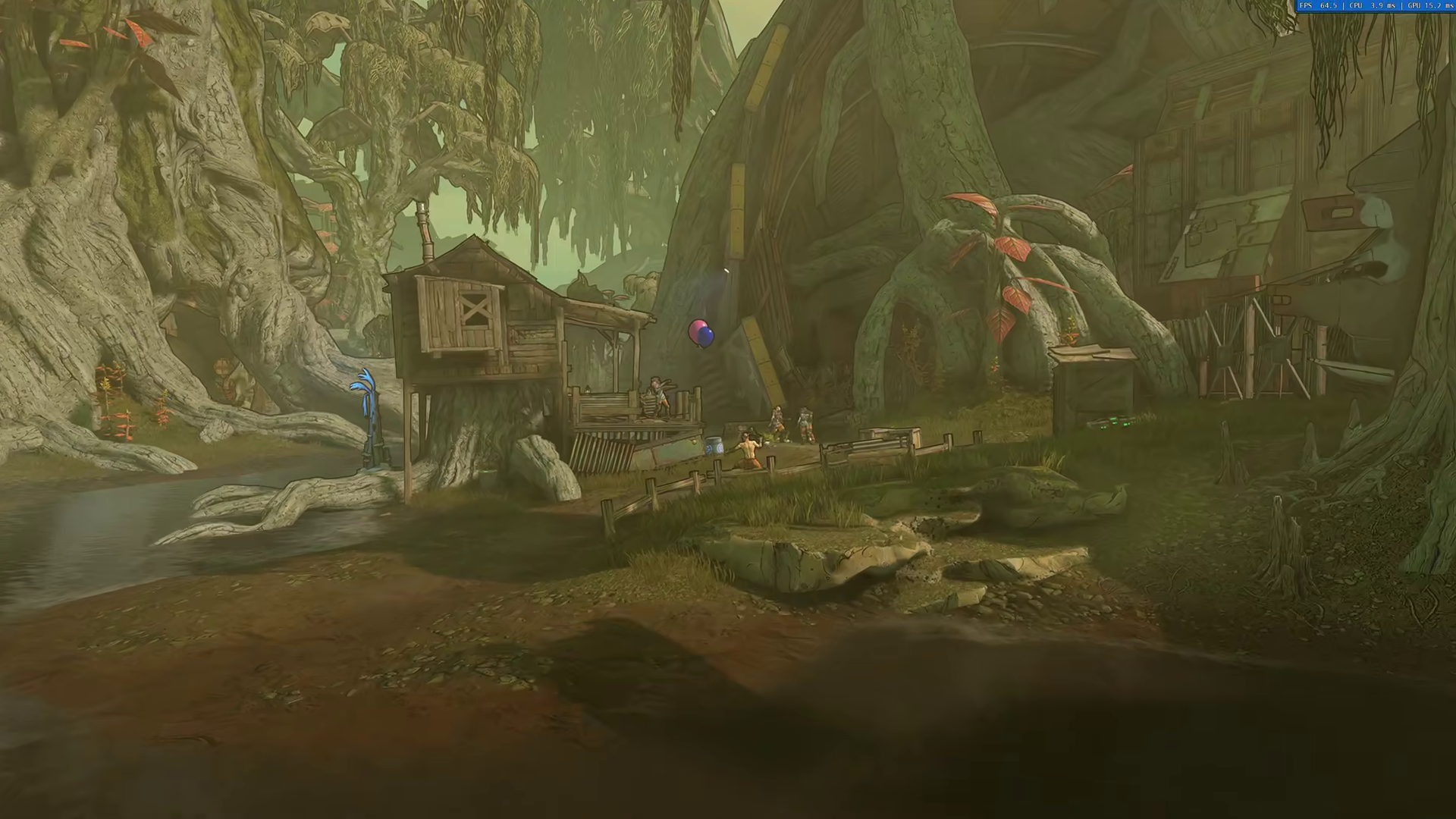



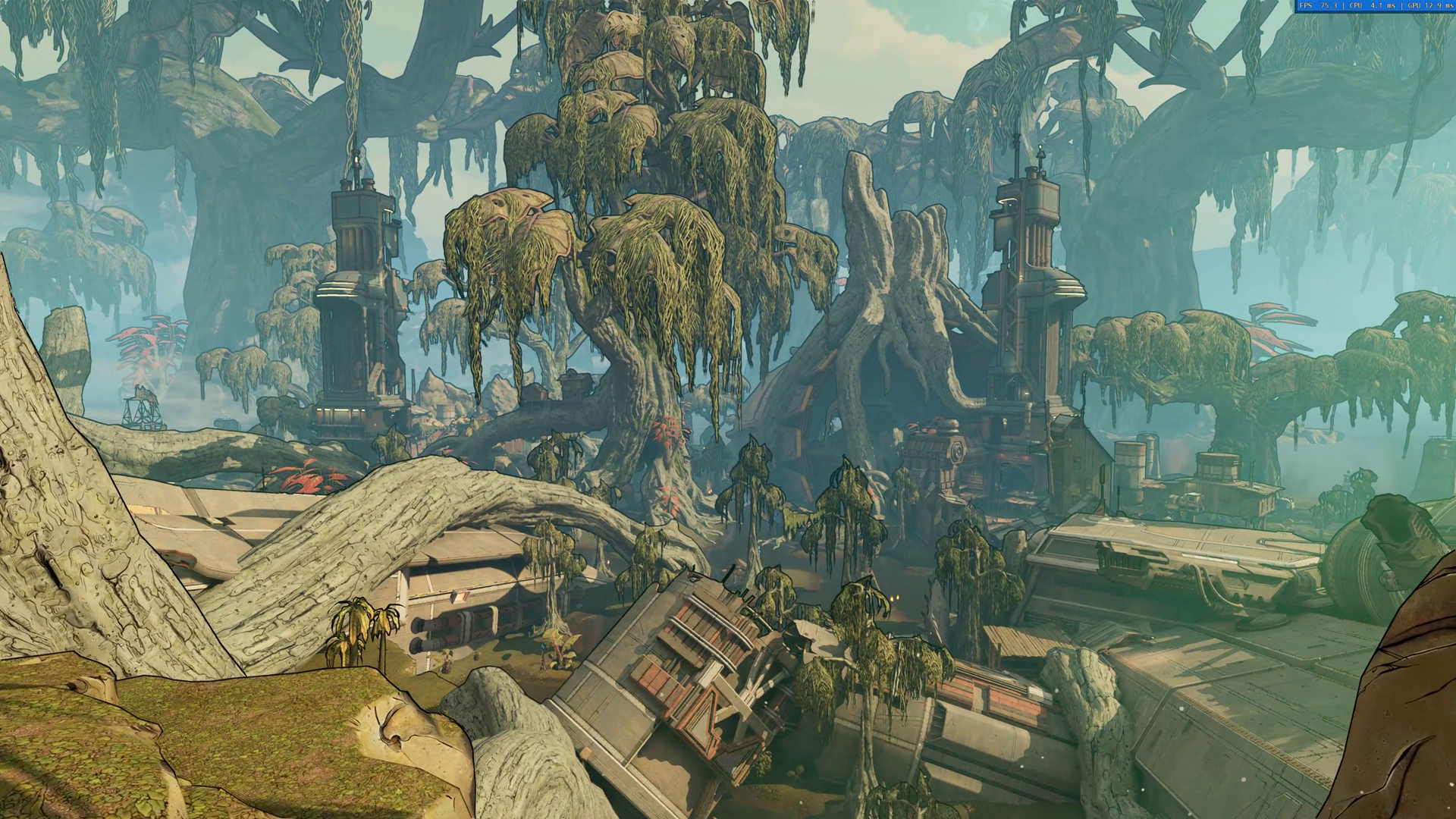















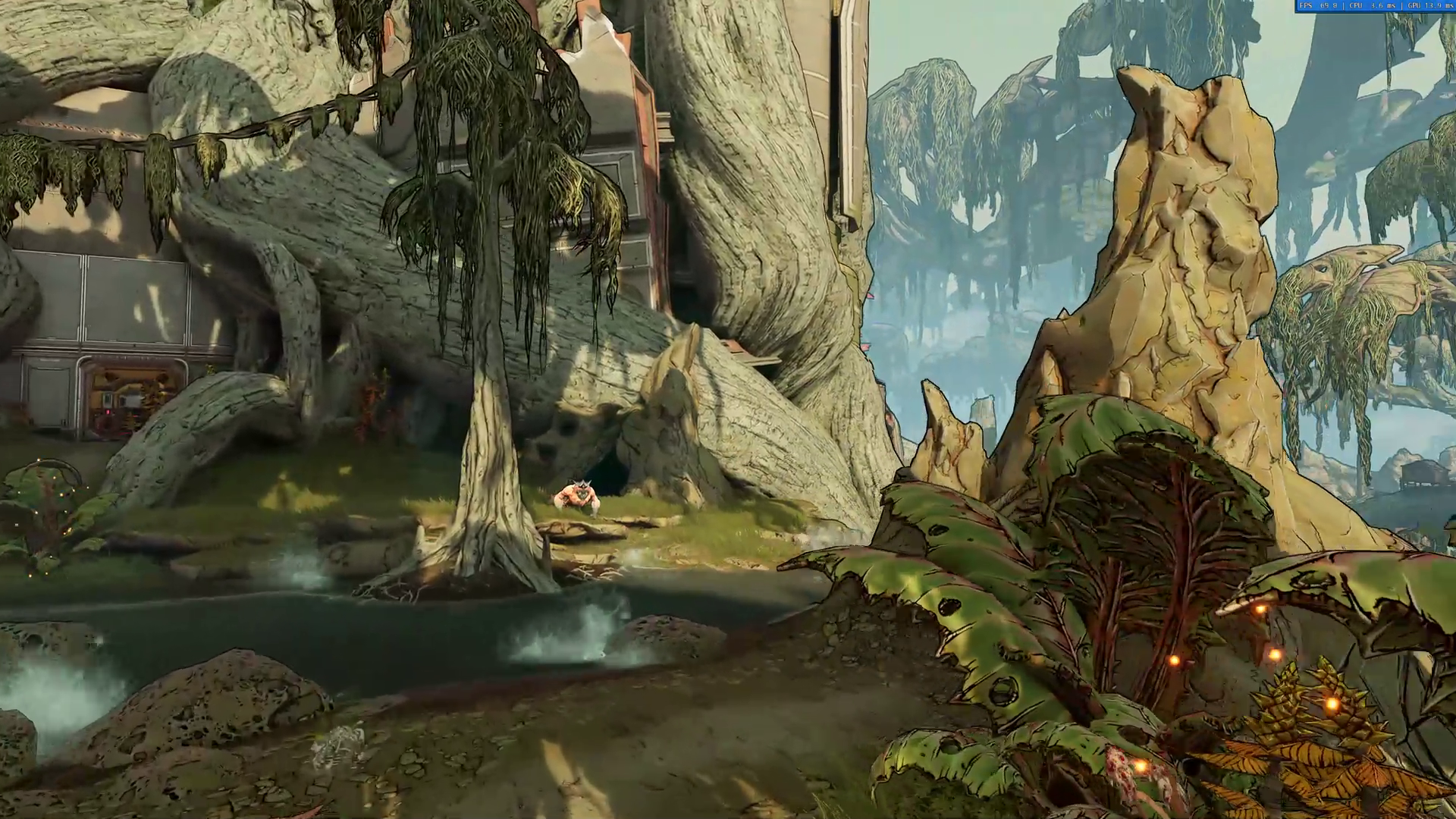
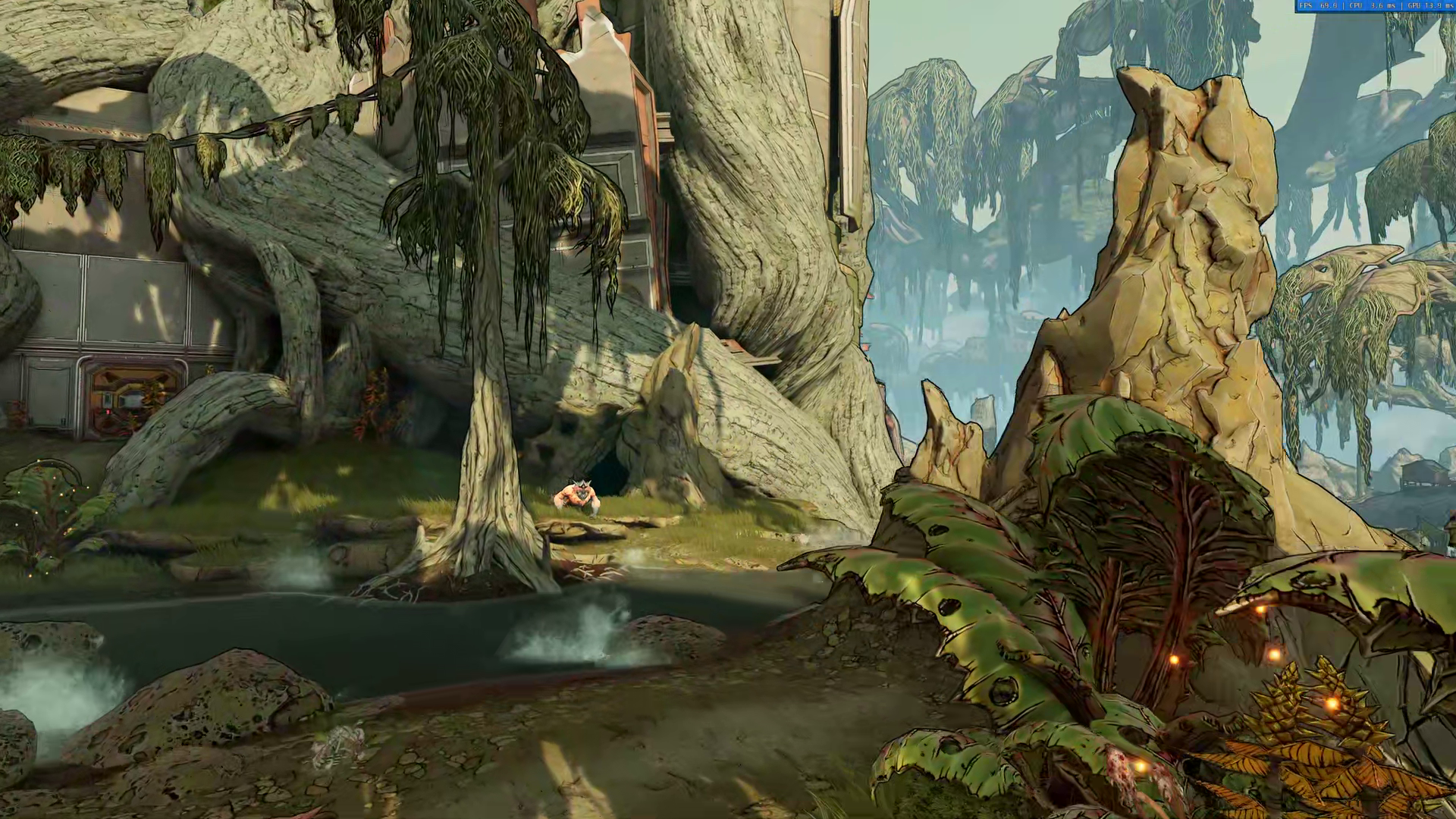
For those that want to see raw comparisons of the various encodes, we've provided a gallery of 27 images from the 1080p video, which consists of the Borderlands 3 built-in benchmark. These are all taken from the 6 Mbps encodes, sort of a "balanced" mode for 1080p. You can clearly see the compression artifacts on the H.264 encodes, while HEVC (H.265) and AV1 look much closer to the source material. The lower bitrate 3 Mpbs encodes were substantially worse looking, as you'd expect.
If you'd like to see the original video files, without any compression, I've created this personally hosted BitTorrent magnet link:
magnet:?xt=urn:btih:df241d4b80b51ebe47e82fa275385a0fde083bd6&dn=Tom%27s%20Hardware%20Video%20Encodes
For those who are interested, copying that into a BitTorrent client like qBittorrent should do the trick. (If not, let me know in the comments.) I'll try to keep that seeded for the next month or so at least, for anyone that really wants to view the results. It's 7.65GiB of data, spread over 124 files. Seed if you can.
- MORE: Best Graphics Cards
- MORE: GPU Benchmarks and Hierarchy
- MORE: All Graphics Content
Get Tom's Hardware's best news and in-depth reviews, straight to your inbox.
Current page: Intel Arc A380 Video Encoding Performance and Quality
Prev Page Intel Arc A380 Gaming Performance Next Page Intel Arc A380: Power, Temps, Noise, Etc.
Jarred Walton is a senior editor at Tom's Hardware focusing on everything GPU. He has been working as a tech journalist since 2004, writing for AnandTech, Maximum PC, and PC Gamer. From the first S3 Virge '3D decelerators' to today's GPUs, Jarred keeps up with all the latest graphics trends and is the one to ask about game performance.
